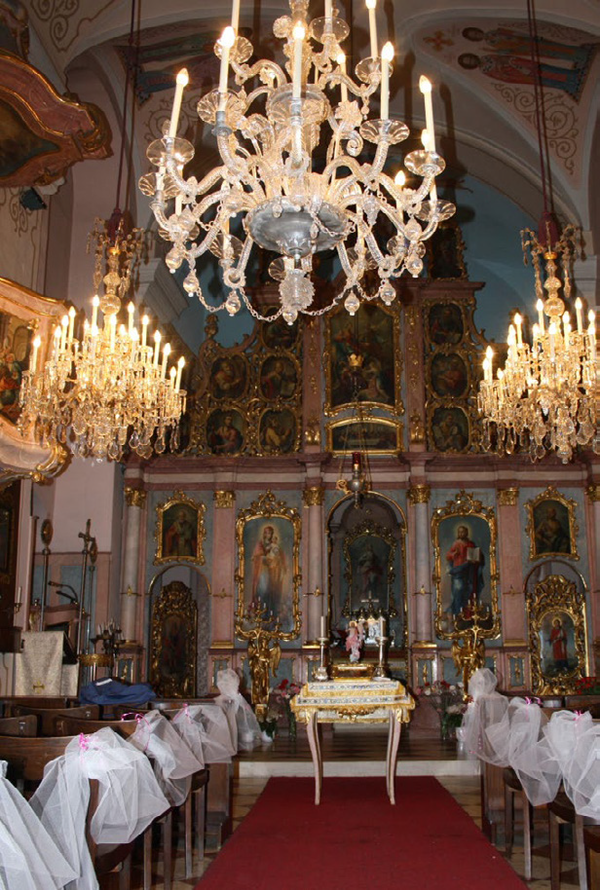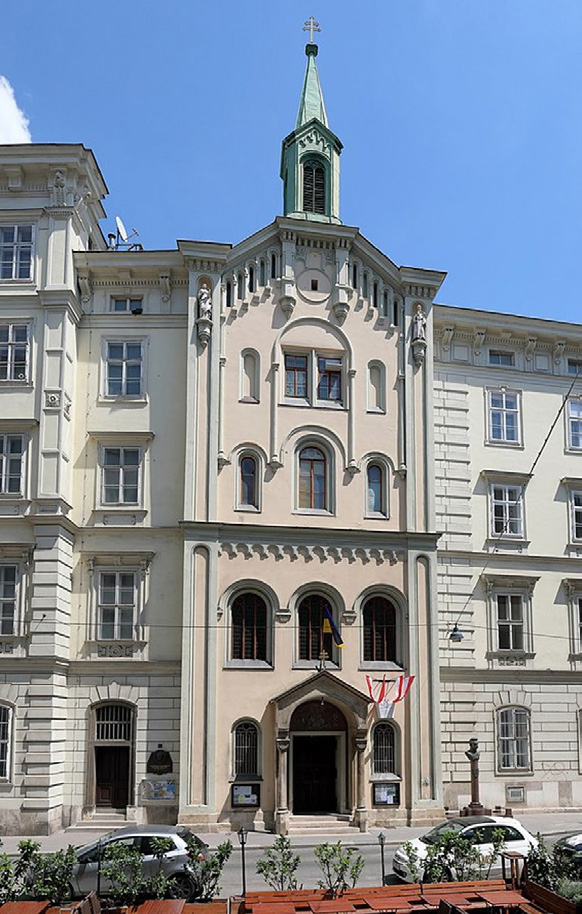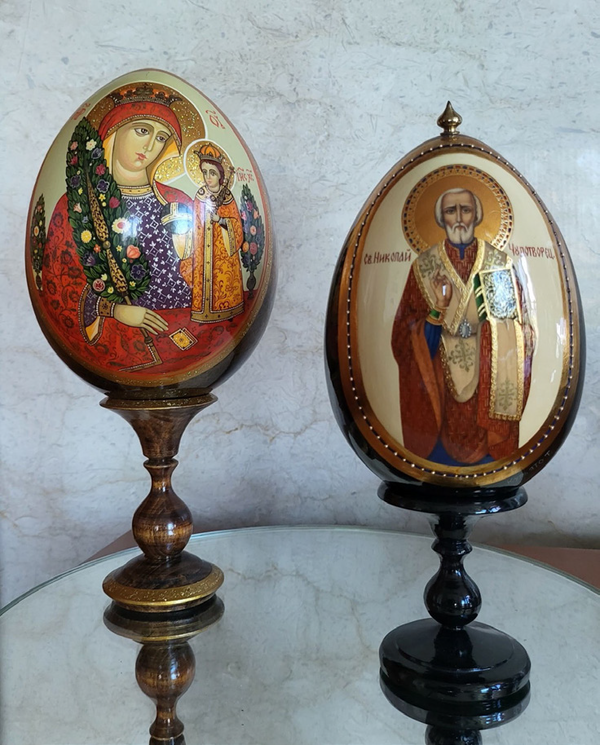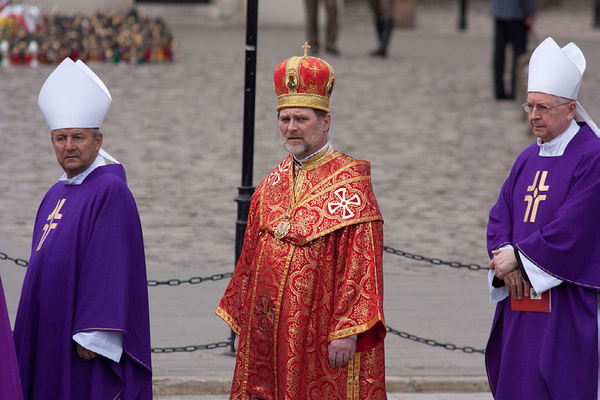
[아츠앤컬쳐] 우크라이나에는 약 3천만 명의 정교회 신자가 있는데, 대부분 우크라이나 정교회-키예프 총대주교청에 속하고 우크라이나 정교회-모스크바 총대주교청도 있다. 소수의 정교회 신자들은 우크라이나 독립 정교회에 속하고, 서부 우크라이나에서는 우크라이나 그리스 가톨릭 교회가 우세하다. 그 외에 개신교, 로마가톨릭교, 이슬람교(주로 크림 타타르인), 유대교가 있고 우크라이나인의 5분의 2 이상은 소속 종교가 없다.
오스트리아-헝가리 제국 시대에 우크라이나 가톨릭은 그리스 우크라이나 가톨릭 교회에 통합된 루테니아 민족에 뿌리를 둔 갈리시아와 로도메리아에서 유래했다(지난 기사 참조). 1596년에 로마 가톨릭 교회와 리투아니아 내에서 폴란드 통치 하의 우크라이나 및 벨로루시 정교회 기독교인들을 통합하는 브레스트-리토프스크 협정이 체결되었다.
소비에트 통치 기간인 1944년부터 당국은 우크라이나 주교들에게 협정을 파기하라는 압력을 가하기 시작했으며, 거부하면 체포하여 투옥하거나 추방했다. 예배, 신학교 및 기타 전통적인 우크라이나 그리스 가톨릭 의식은 소련이 붕괴된 1989년까지 지하에 숨어 있었다.
2019년 1월 키예프 총대주교청과 독립교회는 ‘우크라이나 정교회’라는 단일 교회로 통합되었다. 바르톨로메오 세계총대주교는 1686년부터 모스크바 총대주교청 관할이었던 우크라이나 정교회 공동체의 독립을 공식화했다. 우크라이나 그리스 가톨릭 교회 공동체는 전통적인 로마 가톨릭의 관점에서 보면 조금 특이한데, 가톨릭 전례는 비잔틴어이고 예배 언어는 정교회 전통에서 일반적으로 사용되는 학문적 슬라브어다.

비엔나의 중심부에 위치한 작은 그리스 우크라이나 가톨릭 공동체인 성 바바라 교회도 마찬가지다. 18세기 후반 오스트리아 황제 요제프 2세가 비가톨릭 공동체(우크라이나 가톨릭 포함)에 오스트리아 교회를 지을 수 있도록 특별법을 발표했다. 이 법에 따라 세워진 교회는 외부에서 교회로 인정받지 못한다. 비엔나 성 바바라 공동체의 명목상 수장은 비엔나 추기경 크리스토프 쇤보른이다.
정교회는 순결의 제약이 없다. 정교회에서는 기혼 남성이 주로 부제와 사제 서품을 받는데 독신주의는 예외다. 반면에, 가톨릭 사제는 일반적으로 독신주의 대상으로 결혼이 허용되지 않는다. 가톨릭 교회는 1139년 제2차 라테란 공의회에서 전 세계 사제들에게 독신 생활을 의무화하기로 결정했다. 기존의 성직자의 결혼은 무효로 선언되었다. 독신과 금욕의 영적인 정당성은 “하늘나라를 위해서”이다.
비엔나의 성 바바라 공동체는 폭격을 피해 다른 유럽 국가로 강제이주 당한 우크라이나인과 난민들을 위해 기부와 직접적인 지원에 매우 적극적이다. 비엔나 공동체는 우크라이나 분쟁 이전에 약 1,500명의 회원으로 오스트리아에서 가장 큰 규모였으며, 오스트리아 전역에 5,000명 이상의 우크라이나 가톨릭 신자가 있는데 현재는 이주로 인해 많이 증가할 것으로 예상된다.
그리스 우크라이나 가톨릭 교회는 매우 흥미로운 구조를 가지고 있어 자유주의 신자들에게 매우 매력적인데, 불행히도 가톨릭 교인이 그리스 우크라이나 가톨릭 교회로 전환하는 것을 허용하지 않는 조약이 있다.

Religion in Ukraine
Ukraine has about 30 million Orthodox believers, historically, most adherents belonged to the Ukrainian Orthodox Church–Kyiv Patriarchate, all though the Ukrainian Orthodox Church–Moscow Patriarchate is important as well. A smaller number of Orthodox Christians belonged to the Ukrainian Autocephalous Orthodox Church. In western Ukraine the Ukrainian Greek Catholic Church prevails. Minority religions include Protestantism, Roman Catholicism, Islam (practiced primarily by the Crimean Tatars), and Judaism. More than two-fifths of Ukrainians belongs not to any religious groups.
During the time of the Austrian – Hungarian Empire the Catholic subcategory of the Ukrainian-Catholics originates from Galicia and Lodomeria which is rooted in the ethnic group of "Ruthenians" (read more about in the last article) where integrated into the Greek-Ukrainian-Catholic Church. Starting within 1944 during the Soviet rule authorities began to put pressure on the Ukrainian bishops to dissolve the Union of Brest-Litovsk, an agreement signed in 1596 that united the Roman Catholic Church with Ukrainian and Belorussian Orthodox Christians living under Polish rule in Lithuania. On their refusal, they were arrested and imprisoned or deported. The Church services, seminaries, and other traditional Ukrainian Greek Catholic rites were driven underground which remains until 1989 with the end of the Soviet Union.
In January 2019 the Kyiv Patriarchate and Autocephalous churches were merged into a single Church, the “Orthodox Church of Ukraine”. In creating this new church, Ecumenical Patriarch Bartholomew formalized the independence of Ukraine’s Orthodox community, which had been under the jurisdiction of the patriarchate of Moscow since 1686. The Ukrainian Greek Catholic Church community is a bit odd from a conventional, Roman-Catholic point of view, they claim to be of Catholic faith, but the liturgy used is Byzantine, the language used for services is a scholarly Slavonic language used generally for religious communication in the Orthodox tradition. Even at the Church of St. Barbara, the spiritual centre of the small Greek- Ukrainian-Catholic community, located in the heart of Vienna, the language used for services is a scholarly Slavonic too.

With the release of the Tolerance - patent, an act by Austrian Emperor Joseph II in the late 18th century, in which granted the right to build churches in Austria to non-Catholic communities(apparently this included Ukrainian-Catholics). Churches build under this act, shall not be recognised as a church from the outside. The nominal head of the Vienna community is (the Roman Catholic) Cardinal of Vienna, Dr. Christoph Schönborn.
Orthodox Churches have no Celibacy restriction. Meaning, a priest of the Catholic Church is generally subject to celibacy and is not allowed to marry. In the 12. Century the Catholic Church decided at the Second Lateran Council in 1139 to make celibacy mandatory for Christian priests all over the world. Existing marriages of clergy were declared invalid. The spiritual justification for celibacy and abstinence was "for the sake of the kingdom of heaven." In the Orthodox churches, predominantly married men are ordained deacons and priests, celibacy is the exception.
The community of St. Barbara in Vienna is very active in supporting Ukraine with a lot of donations and direct support for the people in Ukraine and Ukrainians refugees which were forced to move to other European countries, escaping the heavy bombardment. The community in Vienna had approximately 1,500 members before the Ukrainian conflict, it is the biggest one in Austria, but there are more than 5,000 Ukrainian-Catholics in all of Austria (with increasing numbers due to migration), now it is expected to be increased a lot.
The Greek-Ukrainian-Catholic Church has a very interesting structure, which make it very attractive to liberal believers. Unfortunately, the two churches signed a treaty in which those members of the Catholic Church are not allowed to switch to the Greek-Ukrainian-Catholic Church.

글 | 볼프강 슬라빈스키 Wolfgang Slawinski
서울명예시민
한·오스트리아협회 부회장

